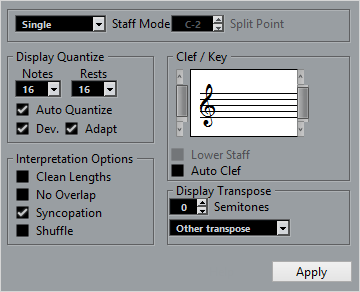Staff Settings Dialog
This dialog allows you to change how Cubase displays the music.
The settings that you make in this dialog are independent for each staff (track), but common for a piano staff that you have created with the Split option.
To open the Staff Settings dialog, do one of the following:
-
Select a staff and select .
-
Double-click in the area to the left of the staff.

The time signature follows the time signatures that are set in the Tempo Track editor. These settings are common to all tracks/staves in the score.
Staff Mode
The Staff Mode determines how the staff is shown.
-
In Single mode, all notes in the part are shown in the same staff.
-
In Split mode, the part is split on the screen into a bass and treble clef, as in a piano score.
The Split Point value determines where you want the split to occur. Notes above and including the split note appear on the upper staff, and notes below the split note appear on the lower staff.
Display Quantize
This section allows you to change the way Cubase displays scores.
These display values are only used for the graphical display in the Score Editor. They do not affect the playback.
- Notes
-
Determines the smallest note value to be displayed and the smallest position to be recognized and properly displayed. Set this to the smallest significant note position used in your music.
For example, if you have notes on odd 16th note positions, set this value to 16. The T values are for triplet note values. This setting is partly overridden by Auto Quantize.
- Rests
-
This value is used as a recommendation. Cubase does not display rests smaller than this value, except where necessary. In effect, this setting also determines how the length of notes is displayed. Set this value according to the smallest note value (length) that you want to be displayed for a single note, positioned on a beat.
- Auto Quantize
-
Allows you to make your score look as legible as possible. Auto Quantize allows you to mix straight notes with tuplets (triplets) in a part. However, Auto Quantize also uses the (display) quantize value. If there is no appropriate note value for a certain note or group of notes, it uses the set quantize value is used to display it.
Generally, only activate this option if your music contains mixed triplets and straight notes. If the part is imprecisely played and/or complex, Auto Quantize may have a problem figuring out exactly what you mean.
- Dev.
-
If this option is activated, triplets/straight notes are detected even if they are not exactly on the beat. However, if you know that your triplets/straight notes are perfectly recorded, either through quantizing or entered by hand, deactivate this option.
This option is only available if Auto Quantize is activated.
- Adapt
-
If this option is activated, the program guesses that when one triplet is found, there are probably more triplets surrounding it. Activate this option if not all of your triplets are detected.
This option is only available if Auto Quantize is activated.
Clef/Key
In this section, you can set the correct clef and key.
- Clef/Key display
-
Allows you to select the clef or key via the scrollbar.
- Lower Staff
-
Sets the clef and key to the lower staff.
- Auto Clef
-
If this option is activated, Cubase attempts to guess the correct clef, judging from the pitch of the music.
Display Transpose
In this section, you can specify a separate display transpose setting for each staff (track). This transposes the notes in the score without affecting how the notes are played back. This allows you to record and play back a multi staff arrangement and still score each instrument according to its own transposition.
- Semitones
-
Allows you to manually set a display transpose value.
- Instrument
-
Allows you to select the instrument for which you are scoring.
Interpretation Options
In this section, you can make additional settings on how the score is displayed.
- Clean Lengths
-
If this option is activated, notes that are considered to be chords are shown with identical lengths. Longer notes are displayed shorter than they are. Notes with very short overlaps are also cut off. This is similar to the No Overlap option, but with a more subtle effect.
- No Overlap
-
If this option is activated, one note is never shown as overlapping another, lengthwise. This allows long and short notes that start at the same point to be displayed without ties. The long notes are cut off in the display. This makes the music more legible.
A sample measure with No Overlap deactivated:

A sample measure with No Overlap activated:

- Syncopation
-
If this option is activated, syncopated notes are shown in a more legible way.
A dotted quarter note at the end of a bar when Syncopation is deactivated:

A dotted quarter note at the end of a bar when Syncopation is activated:

- Shuffle
-
If this option is activated and you have played a shuffle beat, the beat is displayed as straight notes, not as triplets. This is very common in jazz notation.